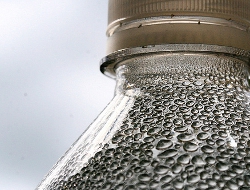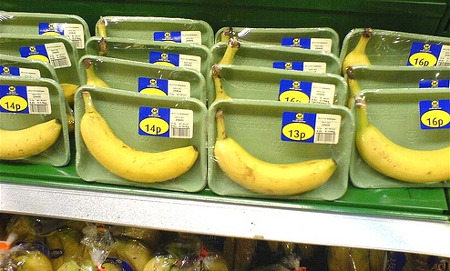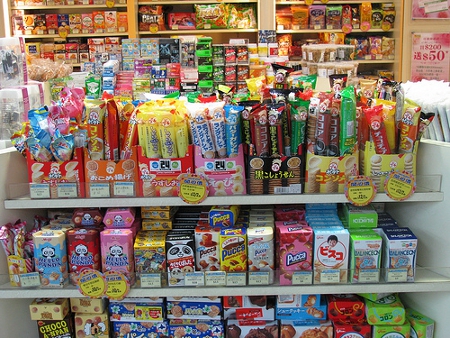Activity: Package Those Foods!
 (Activity courtesy of Chloe Mawer, Duke University, and TeachEngineering)
(Activity courtesy of Chloe Mawer, Duke University, and TeachEngineering)
For the background lesson plan, visit Food Packaging on Teach Engineering.
Grade Level: 7 (6-8). Group Size: 3. Time Required: 50 minutes. Expendable Cost Per Group : US$ 2.
Overview
This activity provides students with the opportunity to create a food package for a specific food. The students have three components to focus on in the design of their food package. The package will have to keep the food clean, protect or aid in the physical and chemical changes that can take place in the food, and identify the food appealingly.
There is a whole industry devoted to packaging engineering, and this industry is expanding as more and more products are created. Packaging engineers have to focus on all the components, which the students will focus on in this exercise which include research, design, production, marketing, and analysis.
Educational Standards
North Carolina Science, Grades 6-8
- 2.03 Evaluate technological designs for application of scientific principles. (Grade 6-8, 2004)
- 2.04 Apply tenets of technological design to make informed consumer decisions about products. (Grade 6-8, 2004)
Pre-Requisite Knowledge
Prior to this activity, students should have a basic understanding of the following:
Physical properties of matter: mass, volume, melting point, boiling point, and texture.
Chemical properties of matter: combustibility, solubility, flammability.
Physical changes: phase change, shape change.
Chemical changes: oxidization, evolution of gas.
Learning Objectives
After this activity, students should be able to:
- Identify four functions of a food package.
- Explain how each food package design works.
- Identify the chemical and physical changes different types of materials prevent or facilitate.
- Explain what a food packaging engineer does.
Materials List
Each group needs:
The materials the group chose for their project and brought from home and the food assigned to the group.
To share with the entire class:
* Scissors
* Tape
* Glue
* Markers
* String
* Stapler/ staples
Attachments
* Food Packaging Materials (.pdf)
* Food Packaging Materials (.doc)
* Food Packaging Rubric (.pdf)
* Food Packaging Rubric (.doc)
* Food Packaging Evaluation (.pdf)
* Food Packaging Evaluation (.doc)
Introduction/Motivation
There is a specialty in engineering that focuses on the food packaging industry. Food packaging engineers have to work hard to produce packages for all types of food that are both marketable and functional in selling the food. Today, students have been contracted by the biggest food company, Food Kings, to create a package for one of their food products. However, the students will only get paid if they create a package that will make Food Kings lots of money. So, they must prepare for their first task as a food package engineer!

Sometimes the package doesn’t really help sell the product.
Vocabulary/Definitions
Boiling point: The temperature at which a substance changes from liquid to gas.
Melting point: The temperature at which a substance changes from solid to liquid.
Phase change: A transition between liquid and gas or liquid and solid.
Solubility: The ability for a substance, the solute, to dissolve in a solvent.
Procedure
Background
The three functions of a food package, as taught in the Food Packaging lesson, are:
1. To keep the food clean.
2. To protect the food product from unwanted physical and chemical changes (such as oxidation and destruction from insects) and to facilitate in desired physical changes (such as heating or cooling).
3. To identify the product and provide sales appeal.
Each group must strive to have their packages fulfill these three functions.
Students must first choose what types of materials they want to make their packages out of. They can research this through the Food Packaging Materials Worksheet as well as the Internet, based on how extensive the teacher wants the research to be. The materials must correspond to the physical and chemical changes that are involved in a group’s food.
Other than choosing materials for the package, students must also choose the structural design of their package. The following are a number of structures with their characteristics and purposes:
Cartons – are rigid and provide support for fluid foods.
Boxes – are usually used as a secondary package to store foods that are sold in quantities larger than one but are individually wrapped and give structure and support.
Bags – are flexible so can be stored easily.
Cans – hold liquids and carbonation well and can be stacked well.
Bottles – hold liquids and carbonation well and are resealable.
Wrappers – are light and do not take up too much space.

Before the Activity
A day or two before the activity:
After going through the Food Packaging Lesson, divide the students into groups of 2 or 3. Assign each group a food to create a package for and allow them to brainstorm the design and types of materials they will need, with help from the Food Packaging Materials Worksheet. Give the students the Food Packaging Rubric so that they know what is expected of their package. Assign the students to bring the materials from home that they would plan to use.
The day of the activity:
Gather the teacher-provided materials (glue, tape, etc). Make sure there is enough for every group to share. Gather the foods that were assigned to the groups.
With the Students
1. Give each student or group of students the food that was assigned to them along with the Food Packaging Rubric.
2. Check to make sure each of the students/groups brought their own unique materials with them, and pass out the materials you are providing (tape, scissors, etc.)
3. Give the students twenty to thirty minutes to create their packages.
4. Once completed, ask each group to share their package with the class as a 2-3 minute presentation to Food King on why their package works.
Assessment
Pre-Activity Assessment
Food Analysis – Ask the students to describe the physical properties of their food and identify the chemical and physical changes that they need to pay attention to in the creation of their food package.
Activity Embedded Assessment
Student Package Evaluations – Students use the attached Food Packaging Evaluation worksheet to evaluate their food package as well as the food packages of three other groups. Groups should each place their package on a desk with a brief description. Then, the students should all walk around individually to fill out their evaluations on different packages.
Post-Activity Assessment
Teacher Package Evaluations – Grade the groups’ work according to the Food Packaging Rubric. The rubric provides an assessment tool for evaluating their designs.
Activity Extensions
Students create their own food prior to this lesson to be packaged. The creation can involve design, analysis of the nutritional content of the food, discussion of the genetic modification of foods among other scientific aspects of food engineering.
For two fun packaging activities, both of which involve cushioning a delicate food item, see our egg drop lesson plan and Pringles challenge.
Activity Scaling
* For lower grades, less functions of a food package can be involved. They could focus more on the shape and aesthetic design of the structure than the materials used to make it.
* For upper grades, more functions of a food package can be involved. They could engage at the fourth function, “for the package to be inexpensive, both in its materials and transportation,” as stated in the background. They could also look more thoroughly into the chemical changes and properties of the food and packaging materials. In some cases, they could test their designs.
References
Read more about the use of this activity and packing engineering in the K-12 classroom here.
American Management Association. Packaging Division. Packaging for Retail Impact, with Specific Applications to the Dairy, Meat, Candy, and Baking Industries. New York: American Management Association, 1965.
Packaging Materials for Food – Practical Answers. Published September 25, 2006. Practical Action. The Schumacher Centre for Technology & Development.
Contributors
Chloe Mawer © 2007 by Engineering K-Ph.D. Program, Pratt School of Engineering, Duke University, including copyrighted works from other educational institutions and/or U.S. government agencies; all rights reserved.
Supporting Program: Engineering K-Ph.D. Program, Pratt School of Engineering, Duke University.
“Water Bottle” by Muffet (Flickr Commons); “Bananas Packaging” by ScrapThisPack (Flickr Commons); “Getting ready for the train trip to Guangzhou” by Gavin Anderson (Flickr Commons)
Filed under: Class Activities, Grades 6-8, Grades 6-8, Lesson Plans








